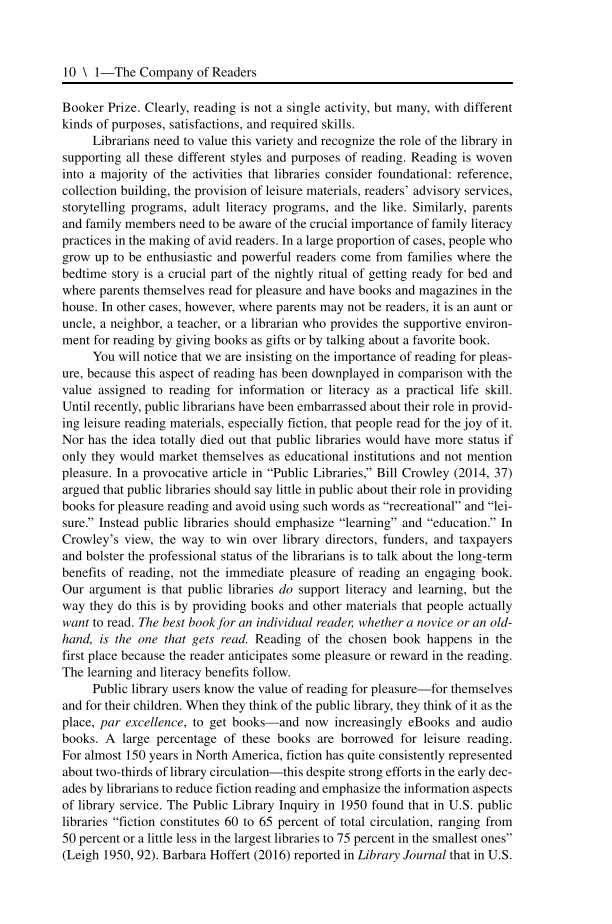Booker Prize. Clearly, reading is not a single activity, but many, with different kinds of purposes, satisfactions, and required skills. Librarians need to value this variety and recognize the role of the library in supporting all these different styles and purposes of reading. Reading is woven into a majority of the activities that libraries consider foundational: reference, collection building, the provision of leisure materials, readers’ advisory services, storytelling programs, adult literacy programs, and the like. Similarly, parents and family members need to be aware of the crucial importance of family literacy practices in the making of avid readers. In a large proportion of cases, people who grow up to be enthusiastic and powerful readers come from families where the bedtime story is a crucial part of the nightly ritual of getting ready for bed and where parents themselves read for pleasure and have books and magazines in the house. In other cases, however, where parents may not be readers, it is an aunt or uncle, a neighbor, a teacher, or a librarian who provides the supportive environ- ment for reading by giving books as gifts or by talking about a favorite book. You will notice that we are insisting on the importance of reading for pleas- ure, because this aspect of reading has been downplayed in comparison with the value assigned to reading for information or literacy as a practical life skill. Until recently, public librarians have been embarrassed about their role in provid- ing leisure reading materials, especially fiction, that people read for the joy of it. Nor has the idea totally died out that public libraries would have more status if only they would market themselves as educational institutions and not mention pleasure. In a provocative article in “Public Libraries,” Bill Crowley (2014, 37) argued that public libraries should say little in public about their role in providing books for pleasure reading and avoid using such words as “recreational” and “lei- sure.” Instead public libraries should emphasize “learning” and “education.” In Crowley’s view, the way to win over library directors, funders, and taxpayers and bolster the professional status of the librarians is to talk about the long-term benefits of reading, not the immediate pleasure of reading an engaging book. Our argument is that public libraries do support literacy and learning, but the way they do this is by providing books and other materials that people actually want to read. The best book for an individual reader, whether a novice or an old- hand, is the one that gets read. Reading of the chosen book happens in the first place because the reader anticipates some pleasure or reward in the reading. The learning and literacy benefits follow. Public library users know the value of reading for pleasure—for themselves and for their children. When they think of the public library, they think of it as the place, par excellence, to get books—and now increasingly eBooks and audio books. A large percentage of these books are borrowed for leisure reading. For almost 150 years in North America, fiction has quite consistently represented about two-thirds of library circulation—this despite strong efforts in the early dec- ades by librarians to reduce fiction reading and emphasize the information aspects of library service. The Public Library Inquiry in 1950 found that in U.S. public libraries “fiction constitutes 60 to 65 percent of total circulation, ranging from 50 percent or a little less in the largest libraries to 75 percent in the smallest ones” (Leigh 1950, 92). Barbara Hoffert (2016) reported in Library Journal that in U.S. 10 \ 1—The Company of Readers
Document Details My Account Print multiple pages
Print
You have printed 0 times in the last 24 hours.
Your print count will reset on at .
You may print 0 more time(s) before then.
You may print a maximum of 0 pages at a time.

















































































































































































































































































